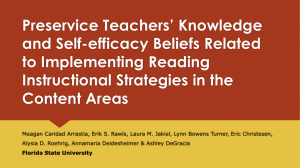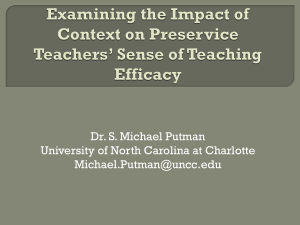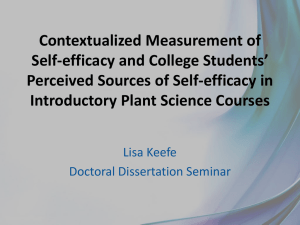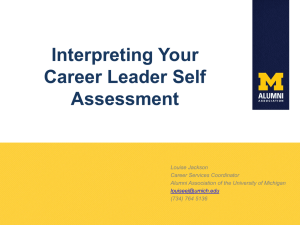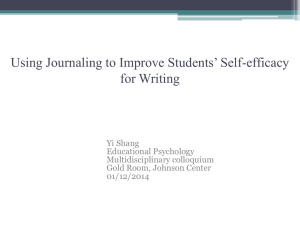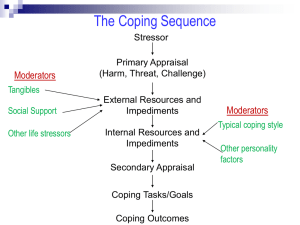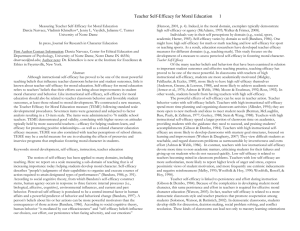Self Efficacy
advertisement
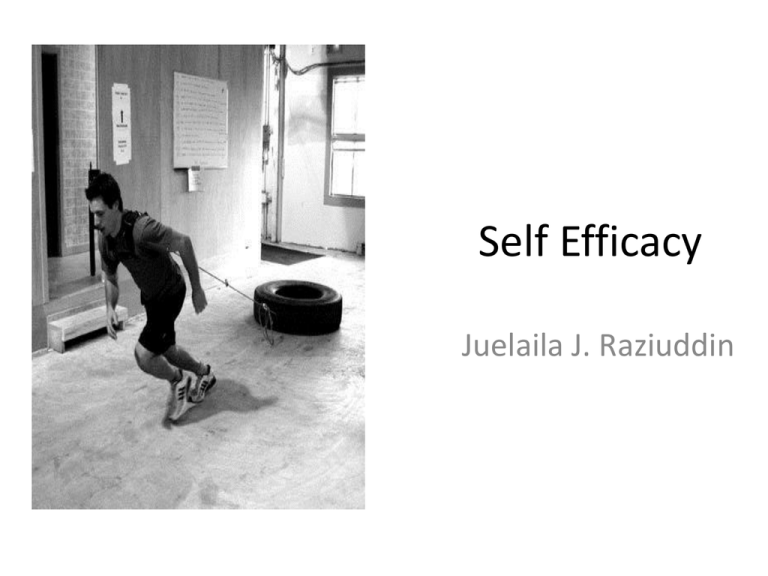
Self Efficacy Juelaila J. Raziuddin Outline • Background: Social Cognitive Theory – ( Bandura, 1997) • Self Efficacy Definition • Self Efficacy vs Self Concept ( Self Esteem) • Empirical Studies – Path Analysis of Self Efficacy on SRL – Static Model and Dynamic Model of interactive Learning Environment Social Cognitive Theory (Albert Bandura ,1997,1986; Frank Pajares,1996) • Definition(social cognitive theory) – one's belief in one's ability to succeed in specific situations – Self-referent thought mediates between knowledge and action;through self-reflection individuals evaluate their own experiences and thought processes – According to Bandura's theory, people with high self-efficacy—that is, those who believe they can perform well—are more likely to view difficult tasks as something to be mastered rather than something to be avoided. Conception of Triadic Reciprocality •How individuals interpret the results of their performance attainments informs and alters their environments and their self-beliefs, which in turn inform and alter their subsequent performances •Interactions that result in a triadic reciprocality • (a) personal factors in the form of cognition, affect, and biological events, •(b) behavior, and • (c) environmental influences •Because personal agency is socially rooted and operates within sociocultural influences, individuals are viewed both as products and as producers of their own environments and of their social systems Outline • Background: Social Cognitive Theory ( Bandura) • Self Efficacy Definition – Self Efficacy vs Self Concept ( Self Esteem) • Empirical Studies – Path Analysis of Self Efficacy on SRL – Static Model and Dynamic Model of interactive Learning Environment Self Efficacy Beliefs • Depending on what is being managed, – May entail regulation of contextual factors • • • • own motivation, thought processes, affective states and actions, or changing environmental conditions – Judgments are made more task-and situation-specific in reference to some type of goal • Thus assessed at a more microanalytic level • Report the level , generality,and strength of their confidence to accomplish a task or succeed in certain situation Self Efficacy vs. Self Concept Self Efficacy Self Concept • concept to relate to more circumscribed situations and activities • concerned with beliefs of personal capability, they are judgments of one's capabilities to perform given actions. • asks, “Can I do this?” • "How confident are you that you can successfully ...." • general attitude toward oneself • is measured at a more general level of specificity and includes the evaluation of such competence and the feelings of self-worth (selfesteem)associated with the behaviors in question. • asks, “How do I feel about myself?”( I know myself) • “How good are you in English?”( Zimmerman,2000) Various Self-Efficacy Constructs Sources of Self Efficacy Beliefs Mastery Experience • the interpreted result of purposive performance, is the most influential source of self-efficacy beliefs. • individuals gauge the effects of their actions, and their interpretations of these effects help create their efficacy beliefs – Success raises self-efficacy; failure lowers it. • important implications for the self-enhancement model of academic achievement ; to increase student achievement in school, educational efforts should focus on raising students' feelings of self-worth or of competence. Vicarious Experience • the effects produced by the actions of others • when people are uncertain about their own abilities or have limited prior experience, they become more sensitive to it. – effects of models are particularly relevant in this context ( Dale Schunk) • Students are likely to develop the belief that "I can do that" when a highly regarded teacher models excellence in an academic endeavor or activity. • involves the social comparisons made with others – peer groups and peer pressure can come into play Social/Verbal Persuasions • • Individuals also create and develop self-efficacy beliefs as a result of the social messages they receive from others. persuasions can involve exposure to the verbal judgments of others ; persuaders can play an important part in the development of an individual's self-beliefs. – Most adults can recall something that was said to them (or done to/for them) during their childhood that had a profound effect on their confidence throughout the rest of their life. – effective persuasions should not be confused with empty inspirational messages – positive persuasions may work to encourage and empower; negative persuasions may work to defeat and weaken self-beliefs Physiological States • anxiety, stress, arousal, fatigue, and mood states • people can "read" themselves, leads to realization of the thoughts and emotional states that individuals have themselves created • they can gauge their confidence by the emotional state they experience as they contemplate an action – However, typical anxiety experienced before an important endeavor is NOT a guide to low self-efficacy. • The butterflies in the stomach phenomenon quite normal apprehension most people experience before important events, • Strong emotional reactions to a task, however, provide cues about the anticipated success or failure of the outcome. – Overly strong arousal can weaken performance. Academic Self Efficacy • refers to a student’s belief that he or she can successfully engage in and complete coursespecific academic tasks, such as accomplishing course outcomes, demonstrating competency skills used in the course, satisfactorily completing assignments, passing the course, and meeting the requirements to continue on in his or her major. Comments? Questions? Outline • Background: Social Cognitive Theory ( Bandura) • Self Efficacy Definition – Self Efficacy vs Self Concept ( Self Esteem) • Empirical Studies – Path Analysis of Self Efficacy on SRL – Static Model and Dynamic Model of interactive Learning Environment Self Efficacy in SRL (Barry J. Zimmerman, 2000) • Affective construct highly accurate predictor of students’ motivational state and their learning effectiveness • relationships among self-efficacy perceptions, selfefficacy for self-regulation, academic self-regulatory processes, and academic achievement • demonstrate that academic self-efficacy mediated the influence of self-efficacy for self-regulated learning on academic achievement • Academic self-efficacy influenced achievement directly (beta = .21) and indirectly by raising students' grade goals (beta = .36). Path Analysis ( Zimmerman, 2000) • self-efficacy and personal goal setting – predict final course grades in high school social studies, increase by 31% over a measure of prior grades in social studies. – compared with the verbal subscale of the Scholastic Aptitude Test, increase 35% of students’ final grades Self Efficacy Model in ITS (Scott W. McQuiggan,Bradford W. Mott, and James C. Lester,2008) • Static model ( online tutorial) • Dynamic model ( physiological state included) Evaluation Data Flow Interactive Learning Environment Evaluation( Crystal Island) Crystal Island Character in the Lab Interactive learning environment user outfitted with biofeedback apparatus ( measures heart rate ) Model Attribute Effects on Self-efficacy Self Efficacy Level: Two level ( High, Low);Three Level( Low,Medium, High);Four Level(Very Low,Low, High, Very High); Five Level (Very Low, Low, Medium, High, Very High) Motivational and affective constructs that both influence (and are influenced by) a student’s physiological state. The heart rate for the student reporting high self-efficacy gradually drops as they encounter a new question, presumably because of their confidence in their ability to successfully solve the problem. This phenomenon is noteworthy since the students were in fact not given feedback about whether or not their responses were correct. Instead the student’s self-appraisal seems to lead to the determination of low efficacy, an inability to successfully achieve at the current task, without a requirement of confirmation of their assessment. Findings on interactive learning environment 150 attributes features for online tutorial;247 attributes feature for interactive LE Dynamic model. As self efficacy granularity increases, accuracy decreases. Results • Encompasses Bandura’s sources of self efficacy; four factors types of effectors – Enactive Mastery Experience • by creating experiences in which the difficulty of the task or specific problems is adapted to the individual student – Vicarious Experience • peer learning companions can create adaptable vicarious experiences for students; a peer companion agent fails or struggles at a task. – Social Persuasion • The impact is determined by the value the student places on the persuader, so an established relationship between a tutor and the student makes verbal persuasion all the more powerful. • Verbal performance feedback ensures that students are aware of goal progression, immersed in challenging tasks, and may contribute to student task persistence. – Physiological State • Self efficacy modeling and affect recognition to operate in tandem • Changes in affective state and the subsequent changes in student physiology will impact self-appraisals of efficacy. What does this all mean? • Relationship of motivation (intrinsic , extrinsic) and self efficacy – Recall Ryan’s class • Relationship of Expectancy Value and Self Efficacy – Recall Dovan’s class What leads to intrinsic motivation? • The development of feelings of competence for a task (Deci & Ryan, 1985) – Related to FOK, JOL – But more closely related to self-efficacy, which we’ll talk about later in the semester • Must be accompanied by sense of autonomy – A sense that you are choosing to do the task What leads to intrinsic motivation? • Choice (Zuckerman et al., 1978), even trivial choice (Cordova & Lepper, 1996) • Challenge (Koestner et al., 1987; Mitchell, 1996) – Self-efficacy models could inform decisions about the appropriate challenge level of tasks to – create adaptive learning experiences that sustain ideal levels of selfefficacy and motivation, – which in turn support effective learning. • Curiosity (Asserted repeatedly in literature, starting with Malone & Lepper (1978), (but couldn’t find any empirical proof of this) • Fantasy Context (Lepper & Cordova, 1992; Cordova & Lepper, 1996) – Although it’s worth noting that their comparisons were between “fantasy” and “no context at all”, which is confounded Self efficacy and Intrinsic,Extrinsic Motivation (Mohammed Chowdhury, 2007) • Empirical results reveal – statistically positive correlations between selfefficacy and performance (r = .289), – self-efficacy and intrinsic motivation (r=. 490), – self-efficacy and extrinsic motivation (.297), – intrinsic motivation and performance (.327), and – extrinsic motivation and performance (.251). students high in self-efficacy and motivation performed better than those low in self-efficacy and motivation. Self Concept and Expectancy Value The self-concept belief represents students' perceptions of their competence in different domains; it is their evaluation of their ability to do a task currently (in contrast to the future orientation of expectancy for success). Eccles and Wigfield are careful to note that these self-concept beliefs can be relatively domain specific and may vary by subject area in school contexts (see also Harter, 1983, 1985a; Marsh, 1989, 1990b). Comments, Questions

